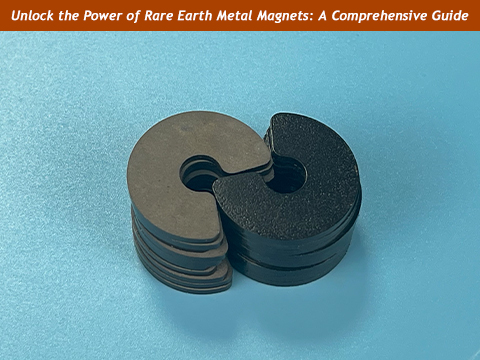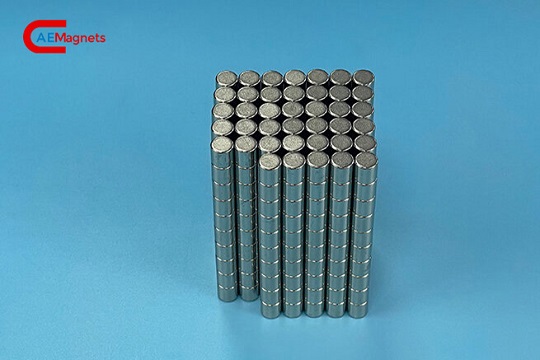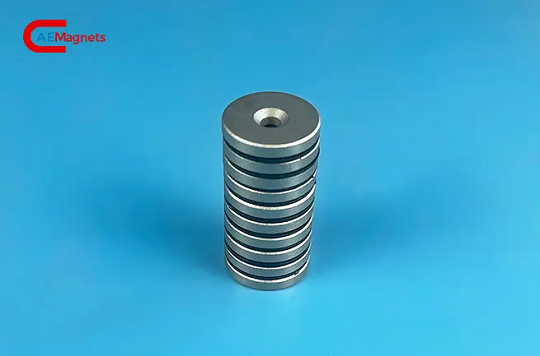
Rare earth metal magnets are a class of high-performance permanent magnets made from rare earth elements. They are specifically found in the lanthanide series of the periodic table. These include neodymium (Nd), samarium (Sm), and a few others. Despite their name, rare earth elements are relatively abundant in the Earth's crust. They are rarely found in concentrated forms that make extraction economically viable. This makes rare earth magnets both valuable and strategically important.
These magnets are renowned for their exceptional magnetic strength. They often outperform traditional options like ferrite and alnico magnets by several magnitudes. Even in small sizes, rare earth magnets can generate powerful magnetic fields. This is why they are essential in miniaturized electronic devices, high-efficiency motors, and advanced industrial systems. Their high coercivity allows them to resist demagnetization. This is especially useful in applications exposed to heat, vibrations, or other harsh conditions.
In short, rare earth metal magnets are the backbone of modern magnetics technology. They allow engineers to create smaller, lighter, and more powerful devices. These devices are used across industries from automotive, aerospace, renewable energy to electronics. Their widespread use underscores just how critical these materials have become in our increasingly electrified and connected world.
Rare earth magnets primarily fall into two major categories: Neodymium Iron Boron (NdFeB) and Samarium Cobalt (SmCo). Each type has distinct physical properties and advantages. This makes them suitable for different industrial needs.

NdFeB magnets, also known as neodymium magnets, are the most powerful permanent magnets available today. Developed in the early 1980s, they quickly became the standard in applications requiring maximum magnetic force within limited space. They are made from an alloy of neodymium, iron, and boron.
These magnets boast energy products ranging from 30 to 52 MGOe (Mega-Gauss Oersted). This makes them ideal for high-efficiency motors in electric vehicles (EVs), robotics, wind turbines, and hard disk drives. However, they are vulnerable to oxidation and corrosion, so they are usually coated with materials such as nickel, epoxy, or zinc. Additionally, standard NdFeB magnets may lose magnetic strength at temperatures above 80°C, although some grades can function effectively up to 200°C.

Samarium cobalt magnets are developed in the 1970s. They offer excellent magnetic strength along with superior thermal and corrosion resistance. Made from samarium and cobalt, these magnets are naturally stable and do not require protective coatings. This makes them ideal for chemically harsh or high-temperature environments.
SmCo magnets have slightly lower maximum energy products (15 to 30 MGOe) compared to NdFeB. However, they can withstand temperatures up to 350°C or higher without losing magnetic properties. This makes them a top choice for aerospace systems, satellite technologies, and military-grade motors.
|
Property
|
Neodymium Magnets
|
Samarium Cobalt Magnets
|
| Max Energy Product (BHmax) | 30–52 MGOe | 15–30 MGOe |
| Curie Temperature | ~310–400°C | ~700–850°C |
| Coercivity | High | Very High |
| Corrosion Resistance | Low (needs coating) | High (no coating needed) |
Rare earth metal magnets offer a range of powerful properties. These properties make them indispensable in modern engineering and design. These advantages go far beyond just strength. They include thermal stability, size efficiency, and adaptability to extreme conditions.
One of the primary benefits of rare earth magnets is their unparalleled magnetic strength. Neodymium magnets, for instance, can be up to 10 times stronger than traditional ceramic magnets. This allows engineers to use smaller components without compromising performance. This is crucial in applications like smartphones, compact sensors, and EV powertrains.
Rare earth magnets retain their magnetization under stress, thanks to their high coercivity. This means they can operate effectively in environments with strong opposing magnetic fields or high mechanical stress. Devices that require stable performance over time—such as servo motors or MRI machines—rely on this stability.
Their ability to generate intense magnetic fields from small volumes reduces the need for bulky assemblies. This is especially important in industries pushing the limits of miniaturization and energy efficiency. For example, drones and electric scooters benefit from lighter motors with greater torque output.
Neodymium magnets have limited temperature ranges. However, high-grade variants and SmCo magnets can perform at elevated temperatures without degradation. This makes them ideal for engines, turbines, and other high-heat environments.
Rare earth metal magnets are embedded in nearly every advanced system we use today. From electric cars to military jets, their unique properties drive performance, efficiency, and innovation. Below are some of the most significant industry applications.

In aerospace, weight and performance are everything. Rare earth magnets are used in actuators, gyroscopes, sensors, and communication systems within aircraft and satellites. SmCo magnets are particular favored. This is due to their ability to withstand extreme temperatures and corrosive environments.
For defense applications, rare earth magnets are found in guidance systems. They are also used in radar technologies and missile actuators. Their resistance to demagnetization ensures reliability in mission-critical environments.

Modern electric and hybrid vehicles heavily rely on neodymium magnets for high-efficiency motors. These magnets allow for compact motor designs that deliver more torque while consuming less energy. They're also used in ABS systems, window regulators, and electric power steering systems.
As the world transitions toward cleaner energy, demand for rare earth magnets in EV drivetrains continues to surge. It's estimated that an average EV motor contains 1–2 kg of neodymium-based magnets.

Rare earth magnets are essential in smartphones, laptops, earbuds, and cameras. They have compact size and strong magnetic field. These properties are perfect for miniature speakers, vibration motors, and data storage systems.
For instance, hard disk drives use neodymium magnets to precisely position read-write heads. This ensures fast and accurate data access. Similarly, true wireless earbuds rely on tiny magnets for both sound delivery and magnetic charging features.

Wind turbines use rare earth magnets in direct-drive generators. This eliminates the need for gearboxes and reduce mechanical failure. These magnets help convert wind energy into electricity more efficiently, especially in offshore or remote installations.
Solar panel systems also benefit from rare earth-based components in inverters, tracking motors, and power storage units.
While rare earth magnets offer superior performance, they come with some limitations and risks. Understanding these challenges can help businesses make informed decisions and avoid operational pitfalls.
Neodymium magnets are highly susceptible to oxidation and corrosion. When exposed to moisture or certain chemicals, they can deteriorate quickly. To mitigate this, manufacturers apply protective coatings such as nickel, epoxy, or gold plating. These coatings, however, may wear down over time, especially in high-friction environments.
Samarium cobalt magnets, on the other hand, have excellent natural corrosion resistance. They can be used in harsh conditions like saltwater environments or chemical processing facilities without additional protection.
Standard neodymium magnets lose performance at temperatures above 80°C. While high-grade variants can operate up to 200°C, they still lag behind samarium cobalt magnets, which can function reliably at 350°C and beyond. This makes material selection critical for engineers designing equipment exposed to heat—like turbines, engines, or welding systems.
Thermal stability is not just about magnet survival—it also affects system efficiency and lifespan. Choosing the right magnet grade based on temperature range is essential to avoid costly failures.
At AEMagnets, we specialize in providing high-quality, custom rare earth metal materials tailored for advanced magnetic applications. With years of experience and a deep understanding of rare earth magnets, we are trusted by engineers and procurement teams worldwide.
Our product range includes NdFeB, SmCo, AlNiCo magnets and so on, available in various purities and forms. We support clients with technical consulting, custom fabrication, and supply chain management to ensure materials meet exact application requirements.
What sets AEMagnets apart:
Rare earth metal magnets have become the gold standard for high-performance, compact, and reliable magnetic solutions. From powering electric vehicles and wind turbines to driving innovation in aerospace and electronics, their importance cannot be overstated.
Choosing the right magnet type—whether neodymium for unmatched strength or samarium cobalt for harsh conditions—can dramatically enhance system performance and longevity. At AEMagnets, we're here to help you make that choice with confidence.
Contact us to help you transform your ideas into cutting-edge applications with the power of rare earth magnetics.
Posted on September 30, 2025 by MagnetAdmin
Posted on May 16, 2025 by MagnetAdmin
Posted on October 14, 2024 by MagnetAdmin
Posted on July 12, 2024 by MagnetAdmin
Posted on June 07, 2024 by MagnetAdmin
Posted on August 07, 2023 by MagnetAdmin
Posted on July 14, 2023 by MagnetAdmin
Posted on July 06, 2023 by MagnetAdmin
Posted on October 10, 2023 by MagnetAdmin
Posted on June 27, 2023 by MagnetAdmin

